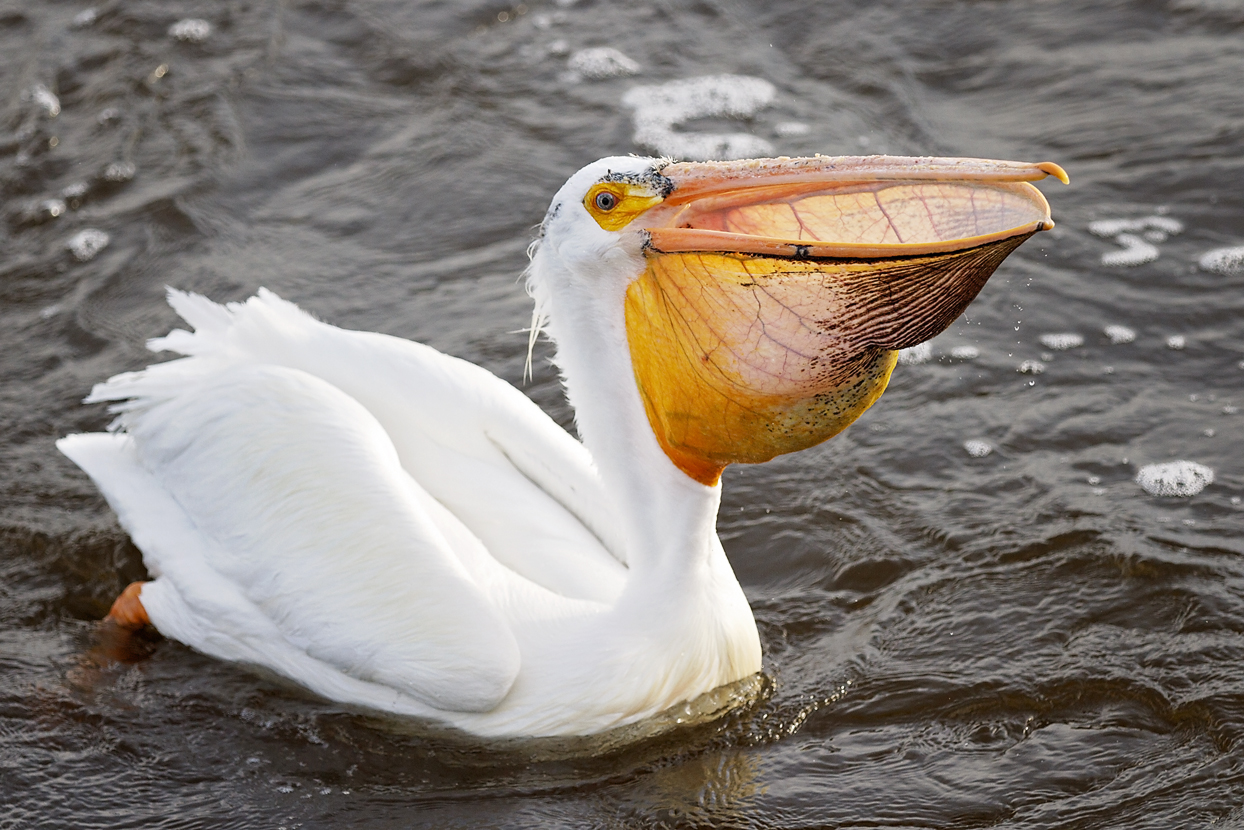For residents of the Meewasin Valley, the American White Pelican (Pelecanus erythrorhynchos) is a harbinger of spring. They’re a welcome sight – but most don’t know their story.
To some, the pelicans are merely a symbol. Saskatchewan endures brutal winters, regularly seeing temperatures drop below -30°C, with darkness, snow, and wind to boot. After months of hostile climatic conditions, a light at the end of the tunnel draws near, and returning just in time to welcome the people of Saskatoon to warmer weather are the pelicans. In some cases, enthusiasm for the return of the pelicans is merely coincidental.
But the inherent value of the American White Pelican goes far beyond symbolism; few who have witnessed the species in person would deny their majesty and grace. They have the second largest average wingspan (240-300cm or 95-125”) of any North American bird, falling just shy of the infamous California Condor; they have huge orange bills atop large throat sacs, with the bills of mating individuals (both male and female) growing a horn during mating season (which they shed after laying eggs); unlike their cousin, the Brown Pelican (Pelecanus occidentalis), they catch their prey while swimming, rather than by diving; and perhaps the most distinctive characteristic of the American White Pelican is their bright-white plumage, with black primary and secondary remiges rarely seen except during flight. Due to their size and instantly recognizable colouration, they are a hard bird to miss.

American White Pelicans (Pelecanus erythrorhynchos) on the South Saskatchewan River. The horns atop the bills of the two pelicans pictured indicate that they are mating individuals.
While the pelican’s plumage has long been admired, in the late 19th and early 20th centuries, this admiration evolved into something more sinister; a defining characteristic of the American White Pelican became a contributing factor in their decline.
This was no fault of their own. Rather, Victorian-era fashion was to blame. In the late 1800s, the epitome of affluence and style in the Western world was to wear large, wide-brimmed hats adorned with silk flowers, ribbons, and yes, exotic plumes. By 1900, more than 5 million birds were being killed each year for their feathers, many of which met their demise in and around Florida’s Everglades.
But how could plume hunting in Florida affect Saskatchewan’s beloved pelicans?
Though plume hunting was particularly popular in the Everglades due to an abundance of ‘exotic’ birds, the practice was not isolated to Florida. But more significantly, American White Pelicans are a migratory species. Their range stretches from the Slave River in the Northwest Territories to Costa Rica (with strays reported as far south as Calamar, Colombia – likely swept off-course by a hurricane). Like many Canadian birds, they fly south for the winter, and return to their northern ranges to nest in spring (with that said, they’ve been observed wintering as far north as St. Paul, Minnesota, and nesting as far south as Albany County, Wyoming). As they migrate they avoid the ocean, opting instead to fly over land, resting in wetlands along the way.

American White Pelican range map. Image Credit: Dakota Birder
Unfortunately, the feather trade was not the only threat the American White Pelicans were facing; more perilous was the destruction of wetland ecosystems across the Americas. By some estimates, 64% of global wetlands have been lost since 1900, including 70% of southern Canada’s. The primary driver of wetland loss is drainage for farming, housing, road construction, and other development.
But perhaps the most serious threat came after the wetlands were converted to farms. In 1874, Austrian chemist Othmar Zeidler first synthesized dichlorodiphenyltrichloroethane, more commonly known as DDT. Discovered to be a powerful insecticide in 1939, DDT was first used in WWII to prevent the spread of insect-borne diseases among troops and civilians. The war ended, and in 1945, DDT hit the shelves, marketed as a pesticide for both agricultural and household use. It was used extensively in agriculture from 1950 to 1980, with over 40,000 tonnes sprayed each year.

An airplane spraying DDT. Image Credit: Wikipedia
Large-scale use of DDT had many unintended consequences, but of particular relevance to American White Pelicans was one: chronic ingestion of DDT, which was inevitable given its widespread use, was demonstrated to thin the walls of eggshells – as if eggs weren’t delicate enough to begin with. DDT had a devastating effect on the success rate of American White Pelican reproduction.
As a result of these factors among others, American White Pelican populations experienced a pronounced decline. They were assessed as an endangered species in many regions.
However, this is not the end of the story.
Rachel Carson wrote Silent Spring, and exposed the dangers of DDT for the world to see; the United States banned the use of DDT in agriculture in 1972, and Canada banned it in 1985. Countless organizations, including Meewasin, committed to protecting wetland ecosystems. And the Migratory Bird Convention Act, 1917 protected American White Pelicans and their eggs from being pursued, hunted, taken, captured, and/or killed. Populations stabilized, and are slowly recovering.

The Northeast Swale, a protected area (containing a wetland ecosystem) in Saskatoon.
This is a story about both the fragility and the resilience of nature. Our actions can have profound, lasting impacts on the world around us – and that goes both ways. Had we not taken action, for example, this story would’ve had a much more somber end; just think of the Passenger Pigeon.
The American White Pelican is not out of the woods yet. The climate is changing, and wetlands continue to be drained – pelicans, among all the other species we share this world with, must always demand our attention, consideration, and respect. Let the return of the pelican serve as an example of what we’re capable of saving.
And let them be a symbol of more than just spring.




